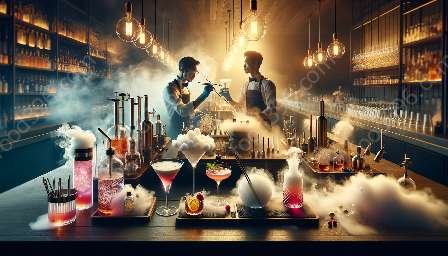Carbonation ingredients play a crucial role in molecular mixology, where science meets art to create innovative cocktails and beverages. In this comprehensive guide, we'll delve into the world of carbonation ingredients, their uses, and the creative possibilities they offer in mixology.
The Science of Carbonation
Carbonation is the process of dissolving carbon dioxide (CO2) into a liquid to create effervescence, or bubbles. This process can occur naturally, as in the case of naturally carbonated spring water, or through artificial means, such as using a carbonation system.
The use of carbonation in molecular mixology is rooted in understanding the science behind it. Mixologists and bartenders leverage carbonation to enhance the texture, aroma, and flavor profile of cocktails, pushing the boundaries of traditional beverage creation.
Carbonation Ingredients
Carbonation ingredients encompass a range of elements and compounds used to introduce carbonation into beverages. These can include:
- Carbon Dioxide (CO2): The primary gas responsible for carbonation, commonly sourced from pressurized tanks or soda siphons.
- Soda Chargers: Small, pressurized cartridges containing carbon dioxide used to carbonate liquids in various molecular mixology techniques.
- Carbonation Drops: Effervescent tablets or liquid solutions that rapidly carbonate liquids when added.
- Carbonation Machines: Devices designed to infuse liquids with carbon dioxide, offering precise control over the level of carbonation.
Each carbonation ingredient offers unique advantages and applications, allowing mixologists to experiment with different techniques and create custom carbonated beverages.
Applications in Molecular Mixology
When applied in the context of molecular mixology, carbonation ingredients unlock a world of creative possibilities. Here are some innovative ways in which carbonation is used in molecular mixology:
- Aerated Cocktails: By infusing cocktails with tiny bubbles using carbonation techniques, mixologists can enhance the mouthfeel and overall sensory experience of the drink.
- Foams and Emulsions: Carbonation ingredients are used to create stable foams and emulsions that add a dramatic visual element and unique texture to cocktails.
- Spherification: Carbonation can be incorporated into the spherification process, where liquid spheres are formed, resulting in surprising bursts of carbonated flavor when consumed.
- Carbonated Garnishes: Fruits, herbs, or other garnishes can be carbonated to add a fizzy and intriguing element to drinks.
These applications represent just a glimpse of the boundless creativity made possible by carbonation ingredients in molecular mixology. By understanding the science of carbonation and experimenting with various ingredients, mixologists can elevate the art of beverage creation to new heights.
Exploring New Frontiers
The world of carbonation ingredients in molecular mixology is ever-evolving, with mixologists continually exploring new techniques and combinations to surprise and delight patrons. By melding scientific principles with artistic innovation, the possibilities for carbonated creations are virtually limitless.
Aspiring mixologists and aficionados alike are encouraged to experiment with carbonation ingredients, expanding their understanding of molecular mixology and pushing the boundaries of traditional cocktail crafting. Through this exploration, they can open up a world of inventive and captivating drinks that redefine the art of mixology.


